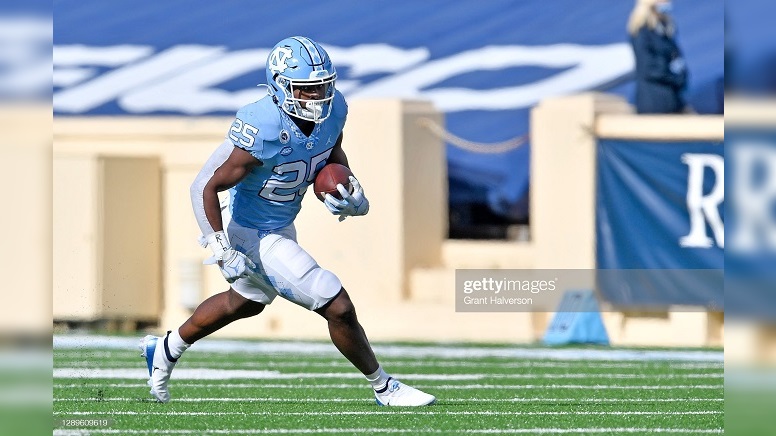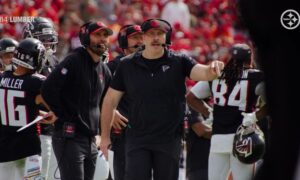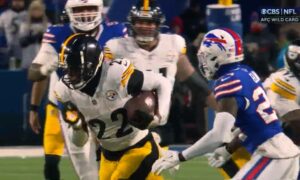I’ve been going down the athletic testing gleaned from pro days and though it might be interesting to share a few of the more important results at positions of particular interest. I usually write big, long articles but these are going to be pretty dense. I will accordingly limit the series to positions of particular interest, and the rounds where I believe the Steelers are likely to have some interest. First off: the Running Backs.
RB Najee Harris, Alabama. He weighed in as a true big back at 6’1⅜” and 232 lbs. but did no field tests. We will have to go with the film alone – a result he no doubt intended, since the film is pretty darned spectacular.
RB Travis Etienne, Clemson. Think he’s just a speedster? Well, his 4.45 dash proves that he is, but he also did that at 5’10⅛” and 215 lbs. That makes him 3″ shorter than Najee Harris but only 17 lbs. lighter, and also ½” taller and 3 lbs. heavier than Javonte Williams. This is not a lightweight! Alas that he did neither of the agility tests, because his film says the results would have been special and could have cemented him as RB1 for most people. As it is, he must remain in a virtual tie for that honor with Najee Harris.
RB Javonte Williams, North Carolina. Everyone’s RB3, who had been vying to get even higher, fell back a bit with the testing. The big issue was coming in at only 5’9⅝” and 212 lbs., which was smaller than expected, and then putting up only “very good” scores across the board. Yes, that adds up to a Top 10-15% athlete. But it also shows that he isn’t a candidate for the Lev Bell trick of losing weight to gain a step. He didn’t lose his RB3 position, but he lost a step on the front runners, and he created some questions about whether he can get any better in the pros.
RB Trey Sermon, Ohio State. He went into his pro day as the RB4-6 for most Steeler fans. He cemented his stock as the clear RB4 with a pretty spectacular show. He isn’t at all small (6’0⅜”, 215 lbs.), but put up the second-best 3-cone time in the class at 6.84 seconds (top 7% of all RB’s ever measured by RAS). The 3-cone test measures short area agility and is supposed to be harder for tall and/or big backs. Sermon is both taller and bigger than most, but managed that feat regardless. His short shuttle, the other agility test, was just average (55th percentile) but his explosion numbers in the broad and vertical were also in the top 10-15% of RAS’s multiyear databank.
But the most striking number was Sermon’s 10-yard split, which put him in the top 2-3% of all the backs on record! These were startling numbers my friends, because he hit top speed faster than even the supposed speedsters. Consider: Tiny Pooka Williams (170 lbs.) ran a 4.46 dash with a 1.54 second 10-yard split. Very quick, as expected. Travis Etienne was even faster with his blazing 4.45, and a split of 1.56. Basically a tie with Pooka except that Etienne is ½” taller and 45 pounds heavier. Trey Sermon’s 40-time was slow by comparison (4.61 seconds), but his 10-yard split was only 1.49 seconds. That isn’t just faster to the 10-yard mark, it is much faster; which means that he has an historic first gear for quick bursts even if his speed won’t extend to cross-the-field TD runs.
It all adds up to this: Trey Sermon is a better athlete than most people thought, with almost unique burst for a man his size, and very quick feet for changing direction. He should be ideal for the short and middle yardage game (scrimmage to 20 yard gains), but not much threat for anything more.
RB Rhamondre Stevenson, Oklahoma. Stevenson measured in at 5’11⅝”, 231 lbs., and then ran a top 15% short shuttle time of 4.15. That’s darned close to Javonte Williams’ 4.09 with almost 20 pounds more on his frame. It confirms what we thought going in: that he’s a Size XL back with amazingly nifty feet. I’ve set him down in ink as my personal RB5. Yes, he failed to show good explosiveness (just average leaps), or speed (slow in both the 40 and the 10-yard split), and was just average in the 3-cone too. He did not set the world on fire. But he did open the door to speculation about what might happen if he followed the Lev Bell route, and dropped a few of those extra pounds. Could he become something special just like Bell did? The numbers and the film combine to say something like this: “Take Benny Snell, and then make him a little bigger and stronger, a tiny bit faster, and hugely more elusive in the hole.”
RB Michael Carter, North Carolina. Carter had been competing with the names listed above in the eyes of many fans, but the measurements lowered his stock significantly. First, he came in at only 5’7⅞”, 201 lbs. That is much smaller than the Steelers’ normal threshhold of 220 pounds. Even Anthony McFarland Jr. weighed in at 208. Carter showed elite, top 5-10% agility in both the short shuttle and the 3-cone tests, but everything else was pedestrian, including his poor 10-yard split (barely a hair faster than Stevenson) and his 4.54 dash. He is off my personal board completely for all intents and purposes, since there is no way he’ll be there in Round 6. Your mileage may vary.
RB Kenneth Gainwell, Memphis. I’m afraid that he fared no better than Carter, because every measurement confirmed that he’s the same player as Anthony McFarland Jr. with a little less juice. He came in at 5’8⅜”, 201 lbs. versus McFarland’s 208 lbs. at ¼” less in height; his 40-time was 4.46 versus McFarland’s 4.44; and his agility scores were in the bottom 25-30%, which won’t make him stand out even though McFarland didn’t run those drills. Why draft the lesser when Pittsburgh already has the better one on its roster with a year of learning under his belt.
So Carter and Gainwell have dropped out of contention, but there haven’t been many other changes in the RB board, and things have been confirmed to some extent.
Round 1 prospects: Najee Harris and Travis Etienne, in whatever order you prefer.
Round 2 prospects: Javonte Williams.
Round 3 prospects: Trey Sermon (early) and Rhamondre Stevenson (late).
Round 4 prospects: Several, but let’s hope we don’t need to find out. They are all closer to Round 5 than Round 3 imho.
BONUS ANALYSIS
I got curious and decided to rank this year’s backs in order with those from last year’s much stronger class. Here’s where I’m at, using my own personal rankings, which did not coincide with either the 2020 draft results or the player’s production as an NFL rookie):
- D’Andre Swift (2020)
- Jonathan Taylor (2020)
- Najee Harris (2021)
- J.K. Dobbins (2020)
- Travis Etienne (2021)
- Clyde Edwards-Helaire (2020)
- Cam Akers (2020)
- Javonte Williams (2021)
- Zack Moss (2020)
- Trey Sermon (2021)
- A.J. Dillon (2020)
- Rhamondre Stevenson (2021)








